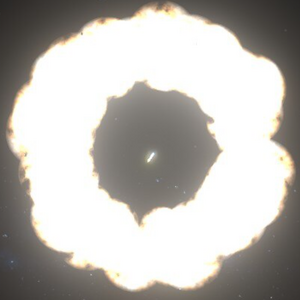(created page for nuclear meltdowns) |
(added extra note for EIME cases) |
||
| Line 5: | Line 5: | ||
Most vessels usually won't have an issue with the reactor going critical as long as there's propellant and a way to vent heat. The [[Radiator|radiators]] can handle nominal usage of the reactor in most cases, however if the temperature goes above 5 500 Kelvin, the emergency cooling protocol engages and uses the RCS thrusters to aide with dumping the heat through propellant until it reaches nominal temperatures of below 4 500 Kelvin. | Most vessels usually won't have an issue with the reactor going critical as long as there's propellant and a way to vent heat. The [[Radiator|radiators]] can handle nominal usage of the reactor in most cases, however if the temperature goes above 5 500 Kelvin, the emergency cooling protocol engages and uses the RCS thrusters to aide with dumping the heat through propellant until it reaches nominal temperatures of below 4 500 Kelvin. | ||
Most reactors will undergo meltdown if they exceed 6 000 Kelvin for an extended time, but can be rescued if the reactor is cooled below that threshold. The [[Model E|EIME]] is a special case with it's [[Stellarator]], as although it has a meltdown threshold of 5 000 Kelvin, that limit is never usually reached as the reactor's iron droplet radiator is incredibly efficient and effective at cooling the reactor. | Most reactors will undergo meltdown if they exceed 6 000 Kelvin for an extended time, but can be rescued if the reactor is cooled below that threshold. The [[Model E|EIME]] is a special case with it's [[Stellarator]], as although it has a meltdown threshold of 5 000 Kelvin, that limit is never usually reached as the reactor's iron droplet radiator is incredibly efficient and effective at cooling the reactor, but not impossible to destroy. | ||
If a vessel completely undergoes meltdown, it explodes, and leaves a [[lifepod]] or [[Core|similar object]] (except for drones and station-sized vessels). | If a vessel completely undergoes meltdown, it explodes, and leaves a [[lifepod]] or [[Core|similar object]] (except for drones and station-sized vessels). | ||
Latest revision as of 19:24, 9 November 2024
Nuclear meltdown occurs when the reactor of a vessel reaches a critical state and is unable to cool itself down before going critical.
Most vessels usually won't have an issue with the reactor going critical as long as there's propellant and a way to vent heat. The radiators can handle nominal usage of the reactor in most cases, however if the temperature goes above 5 500 Kelvin, the emergency cooling protocol engages and uses the RCS thrusters to aide with dumping the heat through propellant until it reaches nominal temperatures of below 4 500 Kelvin.
Most reactors will undergo meltdown if they exceed 6 000 Kelvin for an extended time, but can be rescued if the reactor is cooled below that threshold. The EIME is a special case with it's Stellarator, as although it has a meltdown threshold of 5 000 Kelvin, that limit is never usually reached as the reactor's iron droplet radiator is incredibly efficient and effective at cooling the reactor, but not impossible to destroy.
If a vessel completely undergoes meltdown, it explodes, and leaves a lifepod or similar object (except for drones and station-sized vessels).

